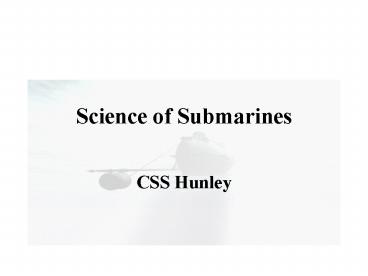Science of Submarines PowerPoint PPT Presentation
1 / 15
Title: Science of Submarines
1
Science of Submarines
- CSS Hunley
2
CSS Hunley
- CSS Hunley background
3
Module Overview
- Learn about the submarine Hunley, its history and
its service during the Civil War. - Learn why the Hunley was a leap in tech-nology
for the period. - Learn about form drag, a retarding force to the
forward motion of a submarine due to its shape.
4
The Hunley a leap in technology
- Adversary ship had gotten larger, no longer
an-chored in small harbors for long periods like
the ships the Turtle faced. Steam power had been
introduced for capital vessels and larger vessels
had deeper drafts. - Distances were much larger, and a submarine had
to go several miles under her own power. - The power selected was human power a crew of 8,
turning a screw. - What was required was a submarine shape that was
more efficient moving through water under power.
5
Forces on a Submarine
Lift
Drag
Thrust
Weight
- There are four forces that affect the
movement of a submarine lift, weight, thrust,
and drag. We exa-mine one of these, drag, and
one form of drag, form drag.
6
Form Drag
- Form drag, or pressure drag, is directly related
to the shape of submarine body a smooth,
streamlined shape will generate less form drag
than a blunted or flat body. - Form drag is easy to demonstrate using a hand out
the window of a moving car. If the hand is held
flat, like a wing, its a streamlined object. The
person feels only a small tug or drag. If the
hand is turned so that the palm is facing
forward, the drag force is greatly increased, and
the hand is pulled backwards! Its no longer
streamlined.
7
Scientific Principle
- An equation commonly used to represent the drag
force on an object as it moves through a fluid is - F 0.5Cdrv2S
- where
- Cd is the coefficient for drag
- r is the density of the fluid
- v is the velocity of the object
- S is the projected area of the object
perpendicular to the plane of the flow
8
A Virtual Experiment
- A graduated cylinder is filled with water. Four
different shaped objects (cube, tear drop,
dimpled golf ball, smooth sphere) are dropped in
the cylinder of water and the time for each to
reach the bottom of the cylinder recorded. - What is the relationship between the times to
reach the bottom of the cylinder and the shape
of the objects? - Object drop experiment
9
Experimental Results
10
Experimental Conclusions
- Our virtual experiment suggests that the
resistance of the water to the fall of the
objects depends on the shape of the objects. - The more streamlined objects fell to the bottom
of the tank more rapidly than the less
streamlined objects.
11
More Examples of Drag
- Swimmer on the left has more drag than the
swimmer on the right
12
More Examples of Drag
- On the left, flow visualization of smoke blown
over a tennis ball. Air flow is moving left to
right. The large gap behind the ball is known as
the "wake". Compare this to a smooth bowling ball
on the right. A smaller gap infers less drag.
13
References
14
Glossary
- Viscosity is a measure of much a fluid will
resist flowing. Units of viscosity, defined in
terms of mass, are kilograms per meter second
(kg/m s). - Density is a measure of how much mass (number of
molecules) an object contains. Units of density
are mass per unit volume (kg/m3).
15
Computational Problems

